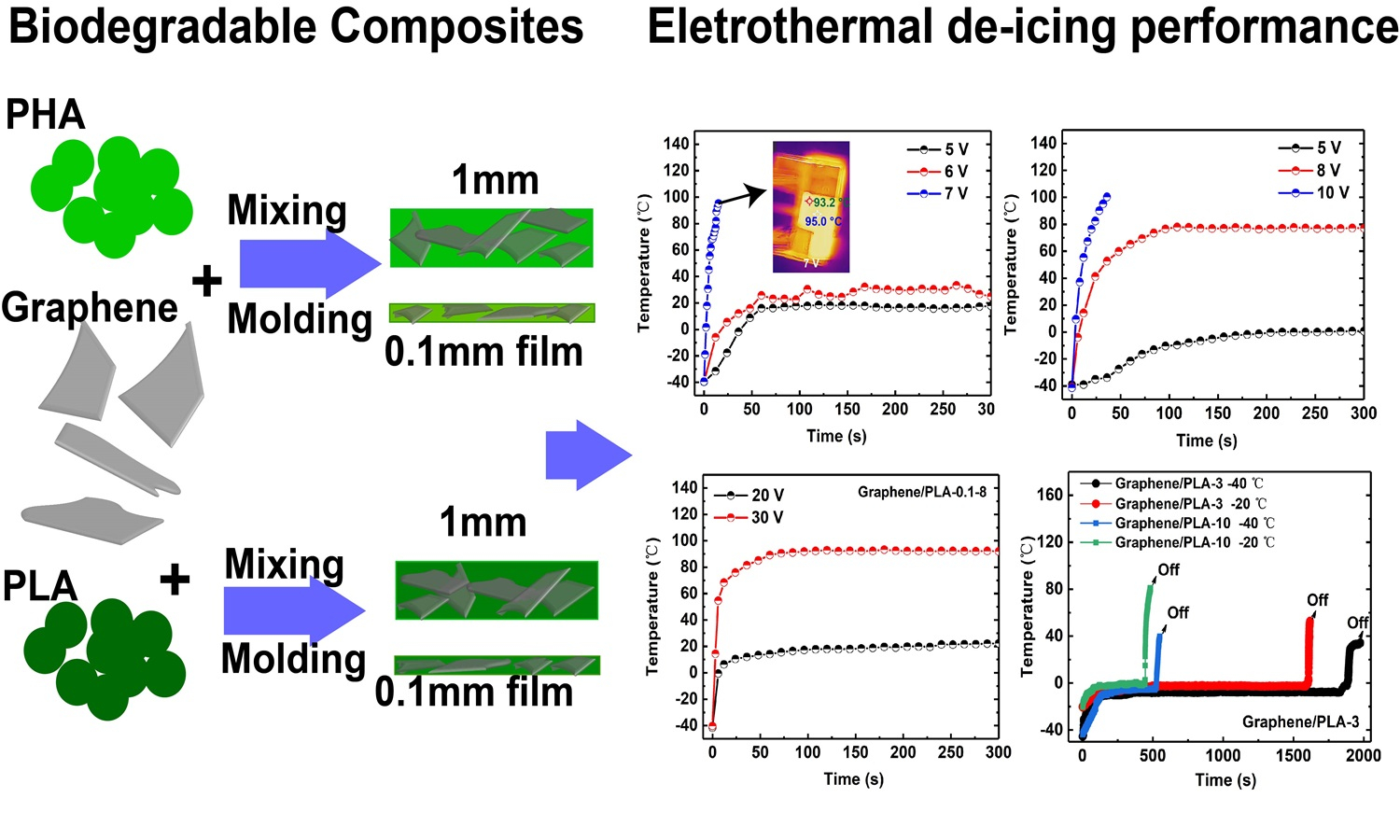Electrical and electrothermal de-icing performance for biodegradable graphene/polyhydroxyalkanoates and graphene/polylactic acid composites
Yijun Liao, Libo Wan, Ting Yin, Yunyi Li, Xiaoli Wu
Vol. 19., No.7., Pages 736-750, 2025
DOI: 10.3144/expresspolymlett.2025.56
DOI: 10.3144/expresspolymlett.2025.56
GRAPHICAL ABSTRACT

ABSTRACT
The electrical and electrothermal de-icing performance of graphene/polyhydroxyalkanoates (PHA) and graphene/polylactic acid (PLA) composites with different thicknesses were systematically compared and investigated. Graphene/PHA with 1 mm thickness shows a slightly lower electrical resistivity than graphene/PLA. However, the results are contrary for 0.1 mm-thick samples, likely due to poorer interfacial adhesion between graphene and PHA. Besides, all 0.1 mm-thick samples show higher electrical resistivity than 1 mm-thick samples, likely attributed to the alignment of graphene. The current-voltage curves of graphene/PHA exhibit nonlinear behavior with fluctuations, whereas all graphene/PLA samples show linear behavior. This result enables the graphene/PLA to exhibit superior electrothermal stability than graphene/PHA. An excellent electrothermal performance is obtained for these composites. The temperature increases from –40.2 to 95 °C within 17 s under 7 V. While these composites cannot be self-heated and utilized above 95 °C, this is because the composites would undergo electrical breakdown when heated to temperatures above 95°C for 5~10 s. The composite can melt ice within 550 s at –40 °C and within 447 s at –20 °C. These findings suggest that graphene/PHA and graphene/PLA composites hold significant potential for de-icing applications.
RELATED ARTICLES
Péter Csvila, Tibor Czigány
Vol. 18., No.10., Pages 1023-1038, 2024
DOI: 10.3144/expresspolymlett.2024.78
Vol. 18., No.10., Pages 1023-1038, 2024
DOI: 10.3144/expresspolymlett.2024.78

The article gives an overview of energy storage composites, their materials, manufacturing processes, and applications. Carbon- and metal-based nanoparticles and their relevant properties are presented. We focus on multifunctional structural supercapacitors and their components. Thus, we describe the main structural electrolytes and elements of the structural electrodes. We show that the nanoparticles significantly influence the electrochemical properties of the electrode. For example, carbon-based nanoparticles can achieve low energy density but high power density, while the opposite is true for metal-based nanoparticles. We show that when carbon- and metal-based nanoparticles are used together, a positive synergy is created between them, promoting the development of favorable electrochemical properties in the electrodes. Furthermore, we present structural supercapacitors and possible ways to introduce nanoparticles into the system. Finally, we present a summary of the progress achieved so far and the advancements expected in the future, as well as potential areas where structural supercapacitors could be used.
Roland Petrény, Ádám Bezerédi, László Mészáros
Vol. 18., No.7., Pages 673-674, 2024
DOI: 10.3144/expresspolymlett.2024.49
Vol. 18., No.7., Pages 673-674, 2024
DOI: 10.3144/expresspolymlett.2024.49

This is an editorial article. It has no abstract.



